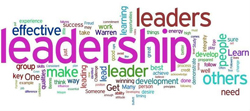 Leadership is both a result and a process; it’s an outcome that is only achieved by the investment we make in it. And that investment takes many forms: learning, practice, feedback, self development, and support. Leadership takes time, so leading requires that we make time for the things that deliver effective leadership.
Leadership is both a result and a process; it’s an outcome that is only achieved by the investment we make in it. And that investment takes many forms: learning, practice, feedback, self development, and support. Leadership takes time, so leading requires that we make time for the things that deliver effective leadership.
Effective leadership requires time, which is one of the reasons leadership is challenging. It doesn’t happen by osmosis or by simply agreeing it’s a good idea. Especially when you consider that “leadership” is a quality that’s determined by those being led.
“If you want to make something happen, you have to make space for it”, goes one of my personal reminders. Read “space” as “time” … and consider some of the following seven leadership behaviours that require an investment of time. You might also want to ask which of them you currently take time for and which you and others might benefit from making a little more time for.
- Thinking critically –“Unless we direct our thinking, we only see familiar patterns”, says Edward De Bono (the Six Thinking Hats guy). Without critical thinking there’s no learning. Disciplined thinking takes effort. It takes reflection. It’s a challenge. Because it requires that we challenge the well-worn, familiar and comfortable neural pathways that have formed our “mental maps” about things. In some ways, all of the points in this article link to this “critical” idea of thinking.
- Expressing appreciation – Thanks and gratitude for specific things others have done. One of the conversations I’ve had frequently in the past couple of years with people in leadership roles has been around how easy it is for many of us to “think” complimentary things of others but struggle or neglect to actually express those thoughts. Of course, others can’t know it if we don’t say it. As a sidebar to this, persuasion researcher Robert Cialdini notes that compliments are a proven way of increasing our persuasiveness with other people. (Yes! 50 secrets from the sience of persuasion.)
- Encouraging input and asking (open) questions – High performing teams have a higher ratio of inquiry versus advocacy than lower performing teams, according to Marcial Losado’s research. In significant part this is due to the more positive and less judgmental environment inquiry creates, because it encourages a more open, honest and learning environment in which better thinking can take place.
- Listening – Yeah, we’ve all heard it (but have we really listened?). Interestingly, as our responsibilities increase, so too does our need to listen – attentively, actively, openly – to others. Partly because we need to be as well informed as we can be (and the further we get from the front line the less we know about what’s really going on) and partly because it shows respect and builds trust in our relationships.
- Looking ahead – “If leaders are to be admired and respected, they must have the ability to see across the horizon of time and imagine what could be”, say Kouzes and Posner in Credibility, citing the results of their research across 25 years which has identified being “forward looking” as the second most most respected and expected characteristic of a leader. (Honesty is number one.) “If they [leaders] don’t know where they are going, no one is likely to go any further ahead with them than they themselves can see.” Heads-up leadership leads to both clearer vision and clearer direction. And it takes time to look up, look out and look ahead.
- Slowing down long enough for others to actually talk to us intelligently – We all know someone who gives off nonverbal (and sometimes verbal) messages that they are just too busy to talk to us, let alone listen to us. Frantically busy people don’t have time to lead, so they’re hard to follow. Constantly checking mobile devices, finishing others’ sentences, agitated body language, distracted eye contact, the head down dash out the door … all of those discourage people from engaging with us. If you want people to talk to you, make sure they know they’re welcome (and please don’t say “my door is always open” … no one’s going to talk to the door! The question is: Are you open?). Slow down and lead!
- Coaching and development – One of the great privileges of leadership is developing others and bringing out the best in individuals and teams. And that takes time. It involves all of the points above. But it also involves an intentional and focused commitment to the task of leadership – one relationship, one team and one business at a time. Talent is the only sustainable competitive advantage a business has, say Bill Conaty and Ram Charan, authors of the Talent Masters: Why smart businesses put people before numbers.) Providing opportunities, support and feedback are among the key things that “create the conditions for success” – which is what we look to leaders to provide.
The great Peter Drucker once said that “Nothing else, perhaps, distinguishes effective executives but their tender loving care of time”. That’s why it’s so important to take the time for leadership.
Guest Author
Aubrey Warren, Australia’s Situational Leadership® master trainer and growth coaching international accredited coach. Used with permission. For more information about leadership and team development, communication training or accredited coaching visit www.pacific.qld.edu.au or call 1300 736 646.








